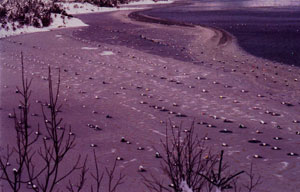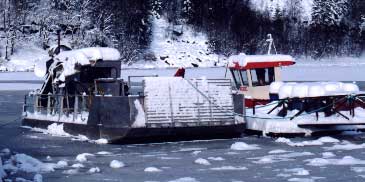Norway Part I
 This year has been one of the most active for me since I entered
the aquaculture industry eight years ago.
We have added more staff, started a new consulting division headed
up by Dr. John Bonardelli, and have expanded operations into Europe.
This year has been one of the most active for me since I entered
the aquaculture industry eight years ago.
We have added more staff, started a new consulting division headed
up by Dr. John Bonardelli, and have expanded operations into Europe.
 Our focus on working with the industry in North and South America,
Oceania, and Asia had allowed us, up to now, to observe the
European aquaculture sector only by way of industry associates or
media, either in electronic or print format.
One of the more interesting parts of our work is visiting farms
and growers as we travel, and comparing notes on the differences
in grow out methods that we have seen. Each visit gives us new
references on how to improve husbandry methods or in many cases
offer technology information to our hosts. As a number of people
in the industry have commented, having us visit them is like
having years of focused travel and observation packed into one
or two days.
Our focus on working with the industry in North and South America,
Oceania, and Asia had allowed us, up to now, to observe the
European aquaculture sector only by way of industry associates or
media, either in electronic or print format.
One of the more interesting parts of our work is visiting farms
and growers as we travel, and comparing notes on the differences
in grow out methods that we have seen. Each visit gives us new
references on how to improve husbandry methods or in many cases
offer technology information to our hosts. As a number of people
in the industry have commented, having us visit them is like
having years of focused travel and observation packed into one
or two days.
 The size of European production and consumption of shellfish
dwarfs North American by comparison, and there is much to
learn, both good and not so good, about what is taking place
across the Atlantic. In this and future columns, I will share
more of the findings of our trips to Norway and to the Netherlands.
The size of European production and consumption of shellfish
dwarfs North American by comparison, and there is much to
learn, both good and not so good, about what is taking place
across the Atlantic. In this and future columns, I will share
more of the findings of our trips to Norway and to the Netherlands.
 John and I were first invited to Norway, through our consulting
group, by a development company in Finnsness, 400km above the
Arctic Circle. The visit took place in February 2001, a time when we
are in the middle of winter at our homes and offices in central
Canada, and rather used to the cold and snow of the four seasons
climate we live in only two hours north of the US border. Still,
we are very south of where we visited. To be more exact, our
offices are close to the 45th parallel, while we were visiting
the 78th parallel of latitude.
John and I were first invited to Norway, through our consulting
group, by a development company in Finnsness, 400km above the
Arctic Circle. The visit took place in February 2001, a time when we
are in the middle of winter at our homes and offices in central
Canada, and rather used to the cold and snow of the four seasons
climate we live in only two hours north of the US border. Still,
we are very south of where we visited. To be more exact, our
offices are close to the 45th parallel, while we were visiting
the 78th parallel of latitude.
 Our director of European
Operations, Terje Steinsund, had arranged our visitation
with the Development Company primarily because Norway had
recently announced that it had set an objective of taking
its mussel industry from 1,000 tonnes per year production
to 100,000 tonnes per year within an 8-10 year time frame.
I applauded the government of Norway for setting this goal,
as I found out a long time ago that once you set a target
or goal, it is a whole lot easier to reach it collectively, rather
than just hoping that your production increases. I have no problem
stating, and many others in the industry would agree, that if
we would nationally set objectives in North America by working
as a team towards that goal, we would collectively guarantee
a greater level of success.
Our director of European
Operations, Terje Steinsund, had arranged our visitation
with the Development Company primarily because Norway had
recently announced that it had set an objective of taking
its mussel industry from 1,000 tonnes per year production
to 100,000 tonnes per year within an 8-10 year time frame.
I applauded the government of Norway for setting this goal,
as I found out a long time ago that once you set a target
or goal, it is a whole lot easier to reach it collectively, rather
than just hoping that your production increases. I have no problem
stating, and many others in the industry would agree, that if
we would nationally set objectives in North America by working
as a team towards that goal, we would collectively guarantee
a greater level of success.
 The purpose of our trip was to examine current husbandry practices
The purpose of our trip was to examine current husbandry practices
 and compare them to best management practices seen around the world,
so as to advance towards the set objectives. As well, we were
asked to discuss with a group of salmon growers the potential
of polyculture applications for salmon and mussel production.
and compare them to best management practices seen around the world,
so as to advance towards the set objectives. As well, we were
asked to discuss with a group of salmon growers the potential
of polyculture applications for salmon and mussel production.
 Polyculture is an area that John and I have been working on for
a while now, and there is more happening than you might think.
The format - from biological, environmental, production,
processing and distribution considerations - makes a lot of sense.
I will discuss more on polyculture in future columns.
Polyculture is an area that John and I have been working on for
a while now, and there is more happening than you might think.
The format - from biological, environmental, production,
processing and distribution considerations - makes a lot of sense.
I will discuss more on polyculture in future columns.
 Being out on the ocean so far north in this area of the world is
not what most people would expect. The effect of the Gulf Current,
which passes northward along the North American coast and then flows
below Greenland and Iceland towards northern Europe, is
in itself a wonder of nature. Average winter ocean temperatures
were in the area of 4-5 degree celsius range, with summer
temperatures in the mid-teens. Perfect for growing salmon,
these conditions, combined with knowledge and attitude, have
positioned Norway as the world's largest salmon producer.
Being out on the ocean so far north in this area of the world is
not what most people would expect. The effect of the Gulf Current,
which passes northward along the North American coast and then flows
below Greenland and Iceland towards northern Europe, is
in itself a wonder of nature. Average winter ocean temperatures
were in the area of 4-5 degree celsius range, with summer
temperatures in the mid-teens. Perfect for growing salmon,
these conditions, combined with knowledge and attitude, have
positioned Norway as the world's largest salmon producer.
 We observed in Norway, as we do in a lot of visits, a variety of
husbandry methods from different areas. Some have good outcomes,
while others are not so efficient.
We observed in Norway, as we do in a lot of visits, a variety of
husbandry methods from different areas. Some have good outcomes,
while others are not so efficient.
 The most popular method we observed is an adaptation of a longline
system with origins in Sweden. The configuration of the system
resembles a grid-like series of parallel longlines which are made
up of a special twisted polyethylene and stainless wire rope.
These high strength, low elongation lines are held apart between
rigid replast bars, and the ends of the system are independently
anchored by very large single plow anchors, or tied to shore. The
back lines are usually two meters apart; some may contain up to
ten parallel lines that span approximately two hundred meters in
length or more. Therefore, a typical grid of two hundred meters by
twenty meters would have 2000 meters of usable longline.
The most popular method we observed is an adaptation of a longline
system with origins in Sweden. The configuration of the system
resembles a grid-like series of parallel longlines which are made
up of a special twisted polyethylene and stainless wire rope.
These high strength, low elongation lines are held apart between
rigid replast bars, and the ends of the system are independently
anchored by very large single plow anchors, or tied to shore. The
back lines are usually two meters apart; some may contain up to
ten parallel lines that span approximately two hundred meters in
length or more. Therefore, a typical grid of two hundred meters by
twenty meters would have 2000 meters of usable longline.
 System configurations can also be ganged together in series, dependent
on the site location. In one case we saw a series of grids that
were almost one kilometer long. Long lines are buoyed according to
the weight on them and adding buoyancy is relatively easy.
Suspended from the longlines are continuous substrates of 4" wide
woven tape that acts as both a collector and primary grow out
substrate.
System configurations can also be ganged together in series, dependent
on the site location. In one case we saw a series of grids that
were almost one kilometer long. Long lines are buoyed according to
the weight on them and adding buoyancy is relatively easy.
Suspended from the longlines are continuous substrates of 4" wide
woven tape that acts as both a collector and primary grow out
substrate.
 Deployment and harvest are usually done from converted fish boats
or specially built barges that have a harvest conveyor/stripper
mounted on the stern of the boat.
Deployment and harvest are usually done from converted fish boats
or specially built barges that have a harvest conveyor/stripper
mounted on the stern of the boat.

This method of husbandry is relatively efficient from a handling and mechanization process, however, from an animal management perspective, it has a number of downfalls. The technique falls into the group used by producers who grow mussels for volume, as opposed to a management strategy that produces mussels for maximum profitability.
 We have seen similar challenges at other locations that we have
observed, however none were quite as pronounced as they were here.
We have seen similar challenges at other locations that we have
observed, however none were quite as pronounced as they were here.
Contact Don Bishop at:
Fukui North America

110-B Bonnechere St.W.
Eganville, Ontario K0J 1T0
CANADA

**NEW**Fax: 613-432-9494
Email: don@bishopaquatic.com or don@bishopaquatic.com
Copyright © 1999-2004 Fukui North America. All rights reserved.